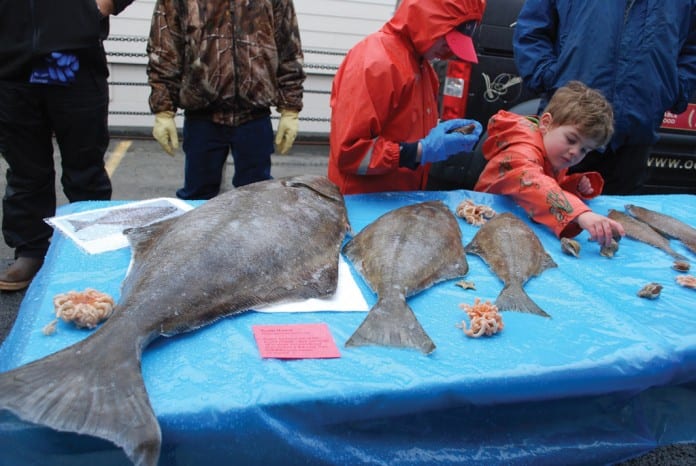
Commissioners of the International Pacific Halibut Commission reached a new agreement in Victoria, British Columbia on Feb. 1 on a coast wide Pacific halibut quota of 38.61 million pounds, an increase of 1.4 million pounds over the 2018 quota.
“While the overall quota for 2019 is a slight increase over 2018, the catch limits agreed to at the meeting reflect a sensible, conservative approach that will secure the future of this iconic and economically important species,” said Chris Oliver, administrator for NOAA Fisheries and recently appointed U.S. commissioner to the IPHC. Olive is also the former long-time executive director of the North Pacific Fishery Management Council in Anchorage.
“We solved several challenging international fishery management issues and we accomplished our goal in the spirit of cooperation and compromise,” Oliver said. “We look forward to working closely with our partners at future meetings.”
The new quota, based on input from stakeholders and analysis from commission science reports, gives Canada a 17.7 percent share and the U.S. an 82.3 percent share, Oliver said. The IPHC also agreed to a 1.65-million-pound allocation for the U.S. West Coast (area 2A) to address tribal, recreational and commercial needs in that area, which includes Washington, Oregon and California. The IPHC now intends to apply that allocation process over the next four years, pending any unanticipated conservation or management concerns.
The agreement reached during the 95th session of the IPHC gives 2A, Washington, Oregon and California, 0.86 million pounds, up 27.04 percent from 0.68 million pounds a year ago. Area 2B, British Columbia, got an allocation of 5.1 million pounds, down 3.70 percent from 5.3 million pounds last year.
Southeast Alaska, Area 2C, got a 1.12 percent boost from 3.57 million pounds to 3.61 million pounds, while Area 3A, the Central Gulf of Alaska, got a 9.66 percent boost from 7.35 million pounds to 8.06 million pounds. Area 3B, the Western Gulf, was allocated 2.33 million pounds, down 11.07 percent from 2.62 million pound, while areas 4A, 4B and 4CDE got big percentage boosts. Area 4A, Aleutian Islands received a quota of 1.65 million pounds, up 20.54 percent. AREA 4B as a quota of 1.21 million pounds, up 15.24 percent from 1.05 million pounds, and Area 4CDE, the Bering Sea, was allocated 2.04 million pounds, up 29.11 percent from 2018.
“We feel that the commissioners made a fairly sound conservation decision for the stocks,” said Linda Behnken, a veteran longline harvester and executive director of the Alaska Longline Fishermen’s Association in Sitka. Behnken, a former U.S. Commissioner on the IPHC, and former member of the North Pacific Fishery Management Council, said she felt some progress had been made in negotiating with Canada toward a more equitable share of the coast wide total, but said one disappointment was that the commissioners did not follow what was a precedent setting unanimous support from U.S. harvesters and processors on distribution of catch limits across Alaska areas, deviating from that somewhat.
“We feel like the overall catch limit was conservative, responsive to current stock status; that there was progress made in identifying equitable sharing of the catch with Canada, and we were a little surprised at the distribution of catch between areas,” she said.
Homer longliner Malcolm Milne, president of the North Pacific Fisheries Association, agreed with Behnken. “I felt 3A (the Gulf of Alaska) got less fish in order to balance the books area Areas2 A, B and C,” he said. “Canada was guaranteed a harvest based on a formula that weighed their harvest over the last five years, which far exceeded the IPHC recommendations.
The IPHC is an independent scientific body consisting of well-educated profession staff with multiple doctorates, and they give scientific recommendations that are negotiated away, he said. A year-by-year comparison of the IPHC recommended catch limits versus the adopted catch limits clearly demonstrates how much overharvest has been negotiated, he said.
Juneau fisheries consultant Heather McCarty said the 2019 agreement during the 95th annual meeting of the IPHC was “a really big deal” coming in the wake of the 2018 meeting, when there was no international agreement. “This year there seemed to be a desire to reach agreement,” she said. “It was more than just an agreement for this year. It goes into the future, locking in the way of determining what they will get,” she said.













